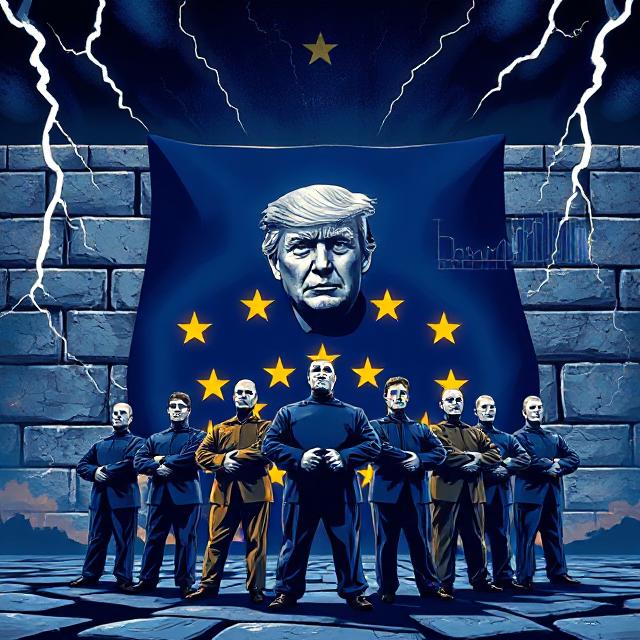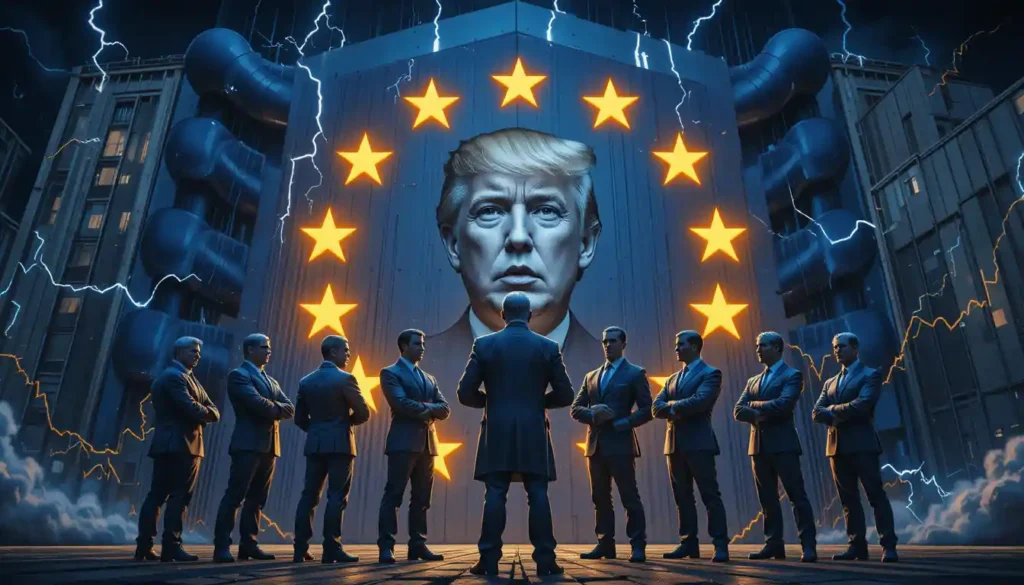Introduction: A Tariff Shock That Rattled the EU
When former President Donald Trump announced the decision to double tariffs on steel imports to 50%, it wasn’t just a political headline—it was a global tremor. EU tariff strategies quickly moved into response mode, scrambling to assess the implications of this bold trade move.
This wasn’t Trump’s first rodeo with tariffs. But the speed and severity of this increase have caught even seasoned analysts off guard. What does this mean for the European Union? How are European leaders, businesses, and citizens responding to Trump’s tariff escalation? Here are 7 key EU tariff reactions shaping the conversation right now.

1. Immediate EU Commission Response: A Call for Rebalancing
The European Commission wasted no time issuing a statement condemning the move. Citing World Trade Organization (WTO) norms, officials called the increase “unilateral and aggressive.”
- EU Trade Commissioner Valdis Dombrovskis called for “balanced rebalancing,” hinting at possible EU tariff measures in response to the U.S. hike. consumer goods like motorcycles and whiskey.
- The EU is currently reviewing the legality of Trump’s move under international trade law.
2. Germany Leads the Industrial Pushback
Germany’s steel industry, one of the most robust in Europe, reacted sharply:
- Germany’s Steel Federation (WV Stahl) voiced serious concern over potential trade disruptions raising red flags about a potential global tariff standoff with widespread economic fallout.
- Auto manufacturers, including Volkswagen and BMW, expressed concern over higher production costs.
Germany is now pushing the EU to consider tariffs on American tech and luxury exports.
3. France: Strategic Retaliation Talks Begin
French officials have taken a diplomatic but firm stance:
- President Emmanuel Macron called the move “economic nationalism at its worst.”
- Behind closed doors, France is reportedly exploring reciprocal EU tariff increases on U.S. agricultural exports like corn and soybeans.
This could affect Midwest farmers, making the move politically sensitive ahead of U.S. elections.
4. Italy: Protectionism Hits Domestic Manufacturing
Italy, with its vast network of small and medium-sized manufacturers, is sounding alarm bells:
- The Italian Trade Agency warned of potential job losses if American imports become more expensive.
- Italy has urged the European Union to protect vulnerable industries like ceramics and home appliances from the impact of new EU tariff retaliation plans.
A proposed relief package for affected Italian exporters is currently under review.
5. Spain: Maritime Industry and Ports at Risk
Spain’s reaction is unique, focusing on its ports and maritime trade infrastructure:
- With major shipping hubs in Valencia and Barcelona, Spain fears a drop in transatlantic cargo volume.
- The Spanish Maritime Business Association is urging the EU to provide subsidies for port-related businesses impacted by trade shifts.
This highlights how deeply interconnected tariffs and logistics really are.
6. Ireland: Diplomatic Channels and U.S. Relations
Ireland is walking a diplomatic tightrope:
- With strong historic and economic ties to the U.S., Ireland is advocating for dialogue over retaliation.
- Irish officials are also pushing for a special EU task force to manage EU tariff negotiations to avoid long-term damage.
Their balanced approach may become a model for other smaller EU nations.
7. European Parliament: Calls for a United Front
Perhaps the most telling reaction has come from the European Parliament:
- A motion was passed urging unity across member states in response to Trump’s tariff policies.
- MEPs are calling for a coordinated tariff strategy, rather than piecemeal responses by individual nations.
This underscores the growing realization that the EU must act as one if it wants to influence U.S. policy effectively.
Table: Summary of Key EU Reactions to Trump’s 50% Steel Tariff
| Country/Institution | Reaction Summary | Potential Action |
|---|---|---|
| EU Commission | Condemns move; considers rebalancing tariffs | Tariffs on U.S. consumer goods |
| Germany | Industrial outcry; fear of trade war | Targeted tariffs on U.S. tech and autos |
| France | Diplomatic protest; strategic retaliation talks | EU tariffs on U.S. agricultural goods |
| Italy | Concern over SMEs; potential job losses | Sector-specific protection and subsidies |
| Spain | Focus on maritime trade and port revenue | Subsidies for shipping industry |
| Ireland | Advocates dialogue; seeks special EU tariff task force | Mediation-oriented approach |
| European Parliament | Urges united EU front in trade response | Coordinated EU tariff strategy |
Expert Insights: A New Chapter in Transatlantic Trade
According to trade analyst Maria Lindholm of the Stockholm Institute for Global Affairs:
“Trump’s tariff escalation signals a return to protectionism that challenges the liberal trade order. The EU must decide quickly if it wants to respond symmetrically or explore new multilateral trade avenues.”
Meanwhile, U.S.-based economist Dr. Robert Feldman warns:
“EU retaliation could provoke a wider trade war. Both sides would benefit more from negotiation than escalation.”
Internal & External Links to Explore
- Understanding EU Tariff Policy
- Trump’s Historical Trade Moves
- Impact of Trade Wars on Global Economy
Be sure to check out our previous article on U.S.-China Tariff Conflicts to understand the wider pattern of trade disputes.
FAQs About Trump’s Tariffs and EU Reactions
- What exactly did Trump announce? Trump Announces Major Steel Tariff Hike – From 25% to 50% In a dramatic shift, President Trump has doubled U.S. steel import tariffs, raising them from 25% to a staggering 50%, intensifying global trade tensions.
- Does this apply only to the EU? No, it applies globally, but the EU is one of the biggest exporters affected.
- How is the EU responding? The EU is mobilizing through diplomatic discussions, proposed countermeasures, and coordinated political efforts to counteract the U.S. move.
- What industries in Europe are most affected? Steel, automotive, manufacturing, agriculture, and logistics.
- Are We on the Brink of a Full-Scale EU–U.S. Trade War? It’s possible if tit-for-tat tariffs continue.
- Will this affect prices in Europe? Likely yes, especially for consumer goods relying on U.S. raw materials.
- Is this legal under WTO rules? A legal review is underway by the EU, with officials considering filing a formal complaint against the U.S. steel tariff hike at the WTO.
- Has Trump done similar things before? Yes, notably during his first term, leading to trade tensions with China and the EU.
- How are U.S. companies reacting? Some support the move, while manufacturers dependent on steel imports oppose it.
- What should EU businesses do now? Assess supply chains and prepare for alternative sourcing or tariff-related costs.
- Could this impact the 2024 U.S. elections? Yes, especially in trade-sensitive states.
- How will this affect EU-U.S. relations long-term? It may strain economic ties and complicate future trade agreements.
Conclusion: Unity or Division?
Trump’s decision to double steel tariffs to 50% has reignited long-standing trade friction, prompting the EU to respond with urgent EU tariff strategies. From Germany’s industrial pushback to Ireland’s call for diplomacy, reactions are varied yet deeply interconnected. The keyword here is unity: the strength of the EU’s response may ultimately shape the future of transatlantic trade.
As we await more live updates and official EU decisions, one thing is clear: this isn’t just about steel—it’s about sovereignty, strategy, and the shifting tides of global power.
What Do You Think?
How should the EU respond? Do you think tariffs help or hurt economies in the long run?
Join the conversation below, share this article, and subscribe to stay informed on the evolving EU tariff landscape.




